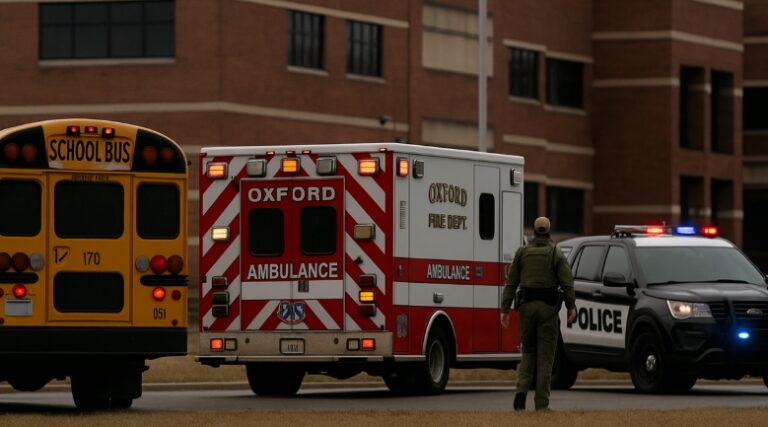On November 30, 2021, a 15-year-old student opened fire at Oxford High School in Oxford Township, Michigan. He killed four classmates and a teacher while injuring 15 more people. Although this tragic incident may have long faded from headlines, its repercussions continue to be felt today.
Last September, Guidepost Solutions released a 275-page report examining the emergency response to the events. While the review found no evidence of neglect or dereliction of duty by individual responders, it identified several key factors that prevented officers from responding as quickly as they would have liked.
What Went Wrong in Oxford?
Time creates distance, and hopefully, clearer heads. Nearly four years later, the Guidepost report is now able to pinpoint three different critical failure areas.
Dispatch Failures
Delays began mounting as soon as the first emergency call was placed. Records from that day show that the first 911 call was made at 12:52:32 p.m. While the Sheriff’s Office was able to dispatch a unit within a minute (at 12:52:59 p.m.), the local Fire Department did not dispatch a unit until more than 7 minutes later at 12:59:56 p.m.
This 7-minute delay, especially for units meant to provide medical assistance, can easily tip the scales for a bleeding victim. Current operational standards require dispatch in under 60 seconds.
Incident Command Delays
On the day of the shooting, officers acted quickly as soon as they arrived on site: they needed just 2 minutes to apprehend the suspect. But once he was in custody, it took 25 minutes for a formal incident command to be established. This meant that for nearly half an hour, EMS workers and ambulances were unable to assist effectively, as they didn’t know where they would be needed.
Communication Breakdowns
An active shooter scenario can change rapidly. During it, it is imperative for all agents on the ground to coordinate their presence quickly. This helps them identify possible escape routes, guide evacuation efforts, and protect themselves when entering a hot zone.
However, during the incident, Fire Command changed radio channels without notifying the officers already on the ground. Meanwhile, some 911 calls were misrouted from Oakland County to Lapeer County.
As a result, officers cleared the same hallways multiple times, while parents waited anxiously for news on their loved ones.

Impact on Officers and First Responders
On the day of the shooting, the generalized confusion placed officers at heightened risk. The first two officers entering the school were unable to provide radio updates on their movements, the locations of the victims, or the conditions, leaving other units without critical situational awareness.
Meanwhile, deputies and supervisors weren’t able to articulate a coordinated, unified response. Nearly 560 emergency personnel from more than two dozen agencies responded, but many lacked established roles, which further complicated the scenario.
Those working under the Fire Department also faced severe preparedness gaps. Some had never received any training for active assailant situations, and the day of the shooting was the first time they donned ballistic vests and helmets.
Without clear command and inadequate protective equipment, the psychological toll compounds physical danger. Responders felt that their own systems had failed both them and the public. In the aftermath, some felt they weren’t given the necessary space and resources to recover from the ordeal.
Community Consequences
The people in Oxford also suffered consequences beyond immediate violence, which affected students, school workers, and parents alike.
Shortly after news about the shooting went public, parents were told that they should meet their children at the local Meijer store. Some families reunited quickly, but families of Madisyn Baldwin, Tate Myre, and Hana St. Juliana waited two hours expecting to reunite with their children, only to be ushered into a breakroom much later and informed that their children were killed.
According to Steve St. Juliana, the communication that day was “just horrid.” The combination of long waits, the constant sight of buses arriving with more children, and the sight of stressed officers all created lasting trauma and an atmosphere of mistrust.
Announcing such devastating news is never easy. Healthcare workers often receive specialized training for this purpose, but most officers that day had not. Amidst intense emotions, uncertainty, and fatigue, officers were pushed into the emotional fray with little notice.
The Funding Factor
Overall, most of the mistakes on November 30, 2021, can be attributed to one critical factor: the chronic underfunding of the county’s Sheriff’s Office and Fire Department.
The Guidepost Solutions report is unequivocal on this matter. Lack of money meant that:
- The Sheriff’s office CAD system was outdated and relied heavily on manual entry
- Under high-volume conditions, 911 calls were misrouted
- There was no unified system to deploy 560 personnel from two dozen agencies
- Police officers and Firefighters did not receive multi-agency active assailant training
- Although the Fire Department has ballistic gear stored away, it is not integrated into regular training
Policy Lessons
When responding to mass casualty events, success depends on what happens during the first five minutes. By waiting for 7 minutes before deployment and delaying command response by 25 minutes, Oxford Township institutions failed to meet this standard.
Eventually, the County approved $500,000 to hire the review firm. This is a step in the right direction, as it demonstrates a commitment to transparency and a willingness to improve their performance in the future. However, implementing the report’s recommendations will require additional funding, which should be allocated now.
Meanwhile, according to ProPublica’s own analysis, the County also failed to include prevention and threat assessment in its response plans. The morning of the shooting, school officials met with the shooter after disturbing drawings. Still, they did not insist that he leave school, alert senior administrators, or check his backpack, which contained the gun and ammunition. While these failures lie with school administrators, they illustrate the broader ecosystem of prevention, preparation, and response that must function cohesively.
Our Perspective
On November 30th, 2021, four students died in a shooting where the perpetrator was apprehended within two minutes, yet systemic failures in command, coordination, and communication created confusion.
That day will likely remain a haunting memory for many families in Oxford Township. But for those tasked with leading the town, it should serve as a lesson: when tragedy hits, poor funding, inefficient communication, and lackadaisical planning can cost lives. These factors keep untrained civilians in harm’s way for longer, directly endangering those who come to help them.
Balanced reforms require both accountability and firm funding commitments. Accountability means conducting thorough after-action reviews and implementing recommended changes. Without proper resources, officers are left to face impossible choices. Funding isn’t optional but essential in saving lives.







